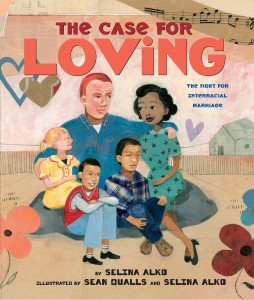Your best friend’s Mom never minds if you make too much noise.
She takes you places and gives you snacks, too. She’s a really nice lady.
Your best friend’s Dad shows you how to do things, and he makes you laugh. You like spending time at their house.
But what if there was a rule somewhere that said they couldn’t be a family? In “The Case for Loving” by Selina Alko, illustrated by Sean Qualls and Selina Alko, there was once such a law, and the reason was black and white.
Falling in love was very easy. Richard Loving and Mildred Jeter did that right after they met, and it didn’t take long for them to decide that they wanted to get married and raise a family.
But there was one problem: Richard was white. Mildred was “colored.” They didn’t think that was any big deal but in Virginia in 1958, it was illegal for them to get married. Yes, a simple wedding could land them in jail!
So Mildred and Richard went to Washington , D.C. and tied the knot there. Family and friends went to the wedding, and everybody was happy. The Lovings “couldn’t wait” to start their new lives back home.
Not long after they were back in Virginia , though, the police came in the middle of the night and said that the Lovings’ marriage certificate was no good. They put Richard and Mildred behind bars because their marriage was unlawful – and that “was just awful!”
In order to stay out of jail for good, Richard and Mildred had to leave their families and move to another state.
In Washington , D.C. again, the Lovings tried to settle in. Richard got a job. Mildred had three children in “three different shades of milk-chocolate brown.” But the city wasn’t a good place for the Lovings. They missed their families. They weren’t happy so, nine years after that late-night visit by the police, because times had changed, they hired lawyers to fight for the right to live in their beloved Virginia …
For any adult who’s too young to remember Loving v. Virginia (or any child who wasn’t born then), “The Case for Loving” is a very informative, eye-opening book.
Author Selina Alko says in her notes that, as a Jewish white woman, she finds it “difficult to imagine” that her marriage (to illustrator Sean Qualls, an African American) might’ve been illegal, fifty years ago. Kids might find that notion to be almost “unbelievable,” too, given that they’ve never known a world like one described here.
What parents will want to understand, however, is this: for its 4-to-8-year-old target age group – particularly for those on the younger end – this book could be scary, especially the “taken away and locked up in jail” part. For toddlers, that’s the stuff of nightmares, so be warned.
Still, if you’re prepared to explain and you keep the youngest audience members in mind, this could be a great read-aloud book. “The Case for Loving” may become one your kids will make noise for.

